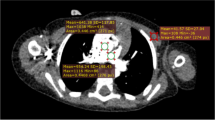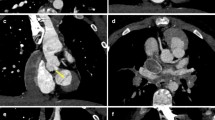Abstract
Neonatal congenital heart disease is a most difficult area of diagnostic radiology because of the small patient body size and fast resting heart rate. Recently, the spatial and temporal resolution of multidetector-row CT (MDCT) has evolved so that neonatal congenital heart disease can be precisely diagnosed. We describe the role of MDCT in neonatal congenital heart disease and offer tips for the scanning procedure to familiarize radiologists with this developing field.













Similar content being viewed by others
References
Leschka S, Alkadhi H, Plass A et al (2005) Accuracy of MSCT coronary angiography with 64-slice technology: first experience. Eur Heart J 26:1482–1487
Tsai IC, Lee T, Lee WL et al (2007) Use of 40-detector row computed tomography before catheter coronary angiography to select early conservative versus early invasive treatment for patients with low-risk acute coronary syndrome. J Comput Assist Tomogr 31:258–264
Raff GL, Gallagher MJ, O’Neill WW et al (2005) Diagnostic accuracy of noninvasive coronary angiography using 64-slice spiral computed tomography. J Am Coll Cardiol 46:552–557
Raman SV, Shah M, McCarthy B et al (2006) Multi-detector row cardiac computed tomography accurately quantifies right and left ventricular size and function compared with cardiac magnetic resonance. Am Heart J 151:736–744
Mahnken AH, Koos R, Katoh M et al (2005) Assessment of myocardial viability in reperfused acute myocardial infarction using 16-slice computed tomography in comparison to magnetic resonance imaging. J Am Coll Cardiol 45:2042–2047
Tanaka N, Ehara M, Surmely JF et al (2006) Images in cardiovascular medicine. Sixty-four-multislice computed tomography image of a ruptured coronary plaque. Circulation 114:e519–e520
Lee T, Tsai IC, Fu YC et al (2006) Using multi-detector row CT in neonates with complex congenital heart disease to replace diagnostic cardiac catheterization for anatomic investigation – initial experiences in technical and clinical feasibility. Pediatr Radiol 36:1273–1282
Tsai IC, Lee T, Chen MC et al (2007) Visualization of neonatal coronary arteries on multidetector row CT: ECG-gated versus non-ECG-gated technique. Pediatr Radiol 37:818–825
Wikipedia (2008) SWOT analysis. http://en.wikipedia.org/wiki/Swot_analysis. Accessed 17 Jan 2008
Soongswang J, Nana A, Laohaprasitiporn D et al (2000) Limitation of transthoracic echocardiography in the diagnosis of congenital heart diseases. J Med Assoc Thai 83 [Suppl 2]:S111–S117
Gutgesell HP, Huhta JC, Latson LA et al (1985) Accuracy of two-dimensional echocardiography in the diagnosis of congenital heart disease. Am J Cardiol 55:514–518
Marek J, Skovranek J, Hucin B et al (1995) Seven-year experience of noninvasive preoperative diagnostics in children with congenital heart defects: comprehensive analysis of 2,788 consecutive patients. Cardiology 86:488–495
Tworetzky W, McElhinney DB, Brook MM et al (1999) Echocardiographic diagnosis alone for the complete repair of major congenital heart defects. J Am Coll Cardiol 33:228–233
Samyn MM (2004) A review of the complementary information available with cardiac magnetic resonance imaging and multi-slice computed tomography (CT) during the study of congenital heart disease. Int J Cardiovasc Imaging 20:569–578
Boxt LM (2004) Magnetic resonance and computed tomographic evaluation of congenital heart disease. J Magn Reson Imaging 19:827–847
Kellenberger CJ, Yoo SJ, Buchel ER (2007) Cardiovascular MR imaging in neonates and infants with congenital heart disease. Radiographics 27:5–18
Chen SJ, Lee WJ, Wang JK et al (2003) Usefulness of three-dimensional electron beam computed tomography for evaluating tracheobronchial anomalies in children with congenital heart disease. Am J Cardiol 92:483–486
Chen SJ, Lin MT, Lee WJ et al (2007) Coronary artery anatomy in children with congenital heart disease by computed tomography. Int J Cardiol 120:363–370
Winer-Muram HT, Rydberg J, Johnson MS et al (2004) Suspected acute pulmonary embolism: evaluation with multi-detector row CT versus digital subtraction pulmonary arteriography. Radiology 233:806–815
Simpson JM, Moore P, Teitel DF (2001) Cardiac catheterization of low-birth-weight infants. Am J Cardiol 87:1372–1377
Vitiello R, McCrindle BW, Nykanen D et al (1998) Complications associated with pediatric cardiac catheterization. J Am Coll Cardiol 32:1433–1440
Hall EJ, Henry S (2004) Kaplan distinguished scientist award 2003. The crooked shall be made straight; dose-response relationships for carcinogenesis. Int J Radiat Biol 80:327–337
Khursheed A, Hillier MC, Shrimpton PC et al (2002) Influence of patient age on normalized effective doses calculated for CT examinations. Br J Radiol 75:819–830
Poll LW, Cohnen M, Brachten S et al (2002) Dose reduction in multi-slice CT of the heart by use of ECG-controlled tube current modulation (“ECG pulsing”): phantom measurements. Rofo 174:1500–1505
Tsai IC, Lee T, Chen MC et al (2007) Homogeneous enhancement in pediatric thoracic CT aortography using a novel and reproducible method: contrast-covering time. AJR 188:1131–1137
Tsai IC, Lee T, Chen MC et al (2007) Gradual pulmonary artery enhancement: new sign of septal defects on CT. AJR 188:1660–1664
Lee T, Tsai IC, Fu YC et al (2007) MDCT evaluation after closure of atrial septal defect with an Amplatzer septal occluder. AJR 188:W431–W439
Cademartiri F, Nieman K, van der Lugt A et al (2004) Intravenous contrast material administration at 16-detector row helical CT coronary angiography: test bolus versus bolus-tracking technique. Radiology 233:817–823
Park MK (2002) Pediatric cardiology for practitioners, 4th edn. Mosby, St. Louis
Keane JF, Lock JE, Fyler DC (2006) Nadas’ pediatric cardiology, 2nd edn. Saunders, Philadelphia
Mavroudis C, Backer CL (2003) Pediatric cardiac surgery, 3rd edn. Mosby, Philadelphia
Author information
Authors and Affiliations
Corresponding author
Electronic supplementary material
Below is the link to the electronic supplementary material.
ESM 1
(AVI 2800 kb)
Supplementary Fig. S1
(GIF 745 kb)
Supplementary Fig. S2
(GIF 2648 MB)
Supplementary Fig. S3
(GIF 775 kb)
Rights and permissions
About this article
Cite this article
Tsai, IC., Chen, MC., Jan, SL. et al. Neonatal cardiac multidetector row CT: why and how we do it. Pediatr Radiol 38, 438–451 (2008). https://doi.org/10.1007/s00247-008-0761-9
Received:
Accepted:
Published:
Issue Date:
DOI: https://doi.org/10.1007/s00247-008-0761-9




